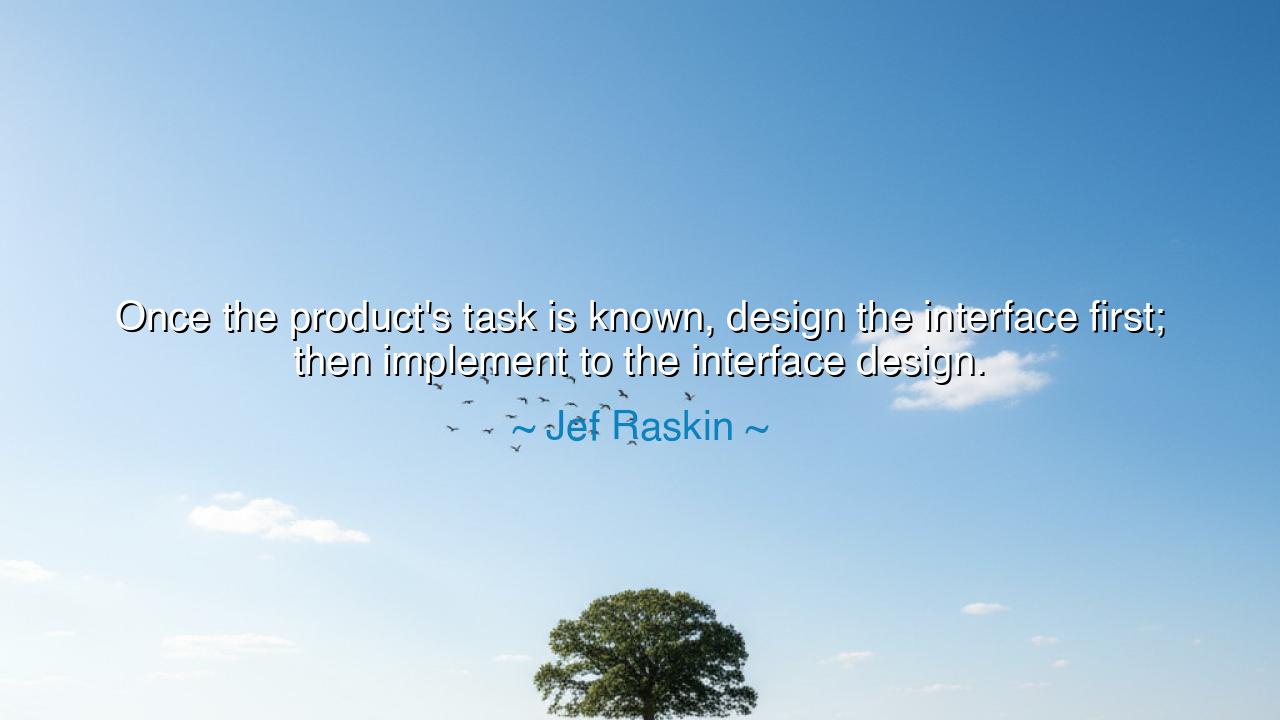
Once the product's task is known, design the interface first;
Once the product's task is known, design the interface first; then implement to the interface design.






“Once the product’s task is known, design the interface first; then implement to the interface design.” Thus spoke Jef Raskin, the visionary father of the Macintosh project, a man who saw not just machines, but the bridge between human and machine. His words, though technical in form, carry the gravity of ancient wisdom: that every act of creation must begin not with the mechanism, but with the human experience it serves. For what is a tool, if not an extension of the mind that wields it? And what is design, if not the art of making complexity feel like simplicity?
In the age of the ancients, artisans understood this truth instinctively. The swordsmith did not forge his blade by random stroke; he began with the hand of the warrior, shaping the hilt to fit the grip before the edge was ever born. The potter’s wheel turned not for its own sake, but for the vessel that would hold water. The sculptor saw first the gesture, the emotion, the human touch—and only then did he strike the marble. Raskin’s principle is the same eternal wisdom: form must serve function, and function must serve humanity. To design the interface first is to begin with empathy—with the user, the soul at the other end of the invention.
Jef Raskin lived in an era when machines were growing powerful but cold, when computers demanded that humans learn their language instead of learning ours. He rebelled against that tyranny. In his vision, technology should bend toward the human, not the other way around. When he says “design the interface first,” he calls us to begin not with circuits, code, or calculation, but with understanding. What does the user see, feel, and need? How should the interaction flow so that the machine becomes invisible, and only purpose remains? For when the interface is clear, the technology beneath may serve with grace. But when the interface is neglected, even the most brilliant system becomes chaos.
History offers examples of both triumph and failure in this truth. When Leonardo da Vinci designed his machines of flight and war, he always began with the movement of the human body—with the arc of the arm, the span of the wing, the curve of motion. It was not the gears that guided his genius, but the interface between man and motion. Centuries later, in contrast, the early computer age created systems so arcane that only the initiated could use them. These were temples of logic but prisons of accessibility. It was Raskin’s vision—manifested through the Macintosh—that broke those walls. By designing first the interface, he made the machine humane. He made it speak, not in numbers, but in experience.
Yet this wisdom extends beyond machines. To “design the interface first” is a philosophy for all creation. Whether one builds a bridge, writes a law, or teaches a lesson, the first question must always be: Who is this for? What will they see? What will they feel? What will make their path smoother, their task more intuitive? To design with empathy is to design with foresight. To build first and think of the user later is to create confusion, alienation, and waste. The ancients would have called it hubris—to craft without listening, to act without understanding.
But when one begins with the interface—with the point where the creation meets its keeper—then harmony emerges. The artist becomes a servant of connection, not a master of complexity. The user becomes not a student of the tool, but its partner. Raskin’s wisdom, though born of silicon and screens, carries the same breath that animated the great builders of old: that all creation, if it is to endure, must honor the human spirit.
So let this teaching be passed down to all who design, lead, or build: begin with the user, not the system; begin with empathy, not ego. Before you code, carve, or compose, ask what it will feel like in the hands of another. The path to greatness lies not in how intricate your mechanisms are, but in how seamless your connection is. For the highest art of design—like the highest art of living—is to make the difficult seem effortless, the complex feel natural, and the machine feel alive in service of the human.
And thus, as Jef Raskin taught, the wise creator does not begin with the machine, but with the soul that will touch it. For only by designing first for human experience can we hope to build not just technology, but tools worthy of humanity itself.






AAdministratorAdministrator
Welcome, honored guests. Please leave a comment, we will respond soon